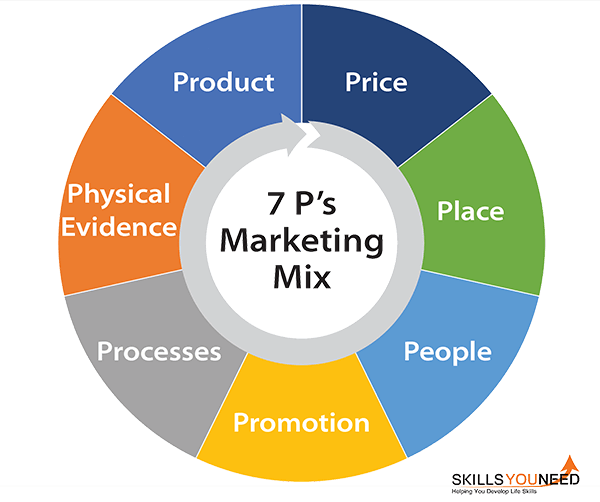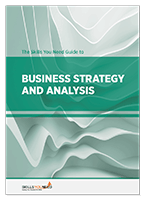The 7 Ps of Marketing Mix
See also: Career Management SkillsThe Seven Ps of Marketing is a relatively simple framework that can be used by any organisation or manager to plan marketing activities and a marketing strategy.
It is useful because it ensures that you look across each area together, and consider how they might be related.
The Seven Ps started as just four: product, price, place and promotion. Over time, as marketers became more aware, and practices and businesses changed, three more have been added: people, processes, and physical evidence.
This page explores each of these areas in turn, looking at the important aspects to consider when planning marketing activity.

Product
Product first, or customer?
Apple is said to have developed the iPod without checking for customer demand first. Steve Jobs was apparently convinced — correctly, as it turned out — that people would want to buy his product.
History, however, is littered with less successful examples of companies who have developed a product first, and worried about finding customers later. It is true that customers do not always know what they want. They do, however, often have an idea of what they lack, or the problem they are trying to solve.
Doing some good customer research in advance of any development costs will ensure that you do not waste any time or money on products that nobody wants to buy.
It is also helpful to check back with your customers during the development to ensure that you are still developing the right product. In particular, check that you are not over-engineering the quality: sometimes good enough is all that is necessary or required.
Price
The price that you charge is important, because it will determine the profit that you make on the product or service.
It must, therefore, be greater than the cost of producing the goods or services.
However, a product is only worth what someone is prepared to pay for it, so it needs to be priced competitively: consistent with what others are charging for similar goods or services.
Pricing also sends a signal to your customers:
- Cheap often indicates a ‘no-frills’ product, without any added extras.
- Expensive may indicate a ‘luxury’ product, or one that has some added value such as improved customer service.
What you charge will therefore influence your customers’ expectations of your product or service, and you need to ensure that you meet those expectations.
Place
‘Place’ describes where and how your customers will buy your product or service, and how it will reach them.
This might be, for example, through your website, or in a particular shop or shops.
In considering ‘place’, you need to decide two things:
- How you will get the goods to that place; and
- How you will get the goods to the customer.
Research shows that delivery of goods bought online is very important to overall customer satisfaction, so should be a part of your overall strategy.
Promotion
Promotion is how you communicate what you do and/or sell to your customers.
'Promotion' includes a whole range of activities, from branding through social media activity and advertising to sales management and special offers. It is designed to show customers why they should buy your product or service, and should therefore focus on benefits, and not just features.
Perhaps the most important thing to remember is that promotion is NOT one-way. Instead, you should see it as the way to start a conversation with your customers, and with your employees, who also need to understand the product.
It is important to look at a variety of channels, including print, online and mobile. Your promotion activity should focus on where your customers are, whether that is particular social media sites, or newspapers.
People
Your customers are unlikely to separate the product or service from those who provide it.
Your staff—and that means anyone who comes into contact with customers, even remotely, through something that they have written for the company website—are therefore vital. They will have an important effect on customer satisfaction. This is even more important now, because so many people are active on social media, and staff therefore can (and will) communicate with customers directly.
Staff will need to be adequately trained to understand their importance, and how to deal with customers.
Further Reading from Skills You Need
The Skills You Need Guide to Business Strategy and Analysis
Based on our popular management and analysis content the Skills You Need Guide to Business Strategy and Analysis is a straightforward and practical guide to business analysis.
This eBook is designed to give you the skills to help you understand your business, your market and your competitors.
It will help you understand why business analysis is important for strategy—and then enable you to use analytical tools effectively to position your business.
Processes
Processes was originally added for service industries, but there is increasing recognition that processes also affect customer experience in product companies.
What’s more, it is very clear that customer experience shapes customer satisfaction.
The experience starts from the first point of contact, and goes on until after the sale, including after-sales service. The process of handling customers at first contact, during sales and beyond, is therefore crucial to overall customer satisfaction. This might include:
- The website, and how the pages load;
- The ordering process: one-click or not, how the customer can pay and so on;
- The information provided to customers after purchase, including about any delays in delivery;
- The delivery time and method, and the way that the person delivering the product behaves; and
- The helpfulness of staff if the customer has to telephone or message for any reason.
Considering the process from end-to-end and from the customer’s perspective can help to avoid problems later on.
Physical evidence
Physical evidence refers to what the customer ‘sees’ of your product. It shows them what it would be like to own or use it.
It therefore includes your website, or your business premises or shop, models wearing your clothes, or photos of them doing so. It also includes customer testimonials, especially if they are on an independent reviewing site, and not under your control.
Like price, the physical evidence sends an important signal to your customer about your product, so it is important that, for example, your website sends the right impression of your product or service.
A collective endeavour
Marketing as a whole relies on all seven Ps.
It is essential to consider them as a whole, and not in isolation. Customers must experience a coherent view of your company and your product, and that can only come from viewing the customer experience from end-to-end across all seven Ps.


